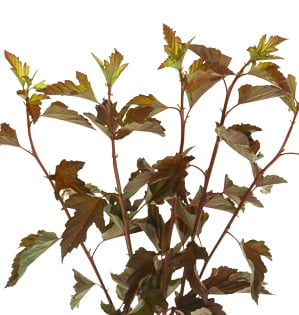Ninebark Foliage

Common Names: Ninebark, Eastern Ninebark Atlantic Ninebark Common Ninebark
Botanical names: Physocarpus opulifolius
Availability: Summer and Fall
Vase life: 7 to 10 days
Storage temperatures: 36 - 40 degrees Fahrenheit
Ethylene Sensitive: No
Description: The leaves of the Ninebark shrub are typically lobed and can resemble those of a maple tree. They are usually 1.5 to 3 inches long and 1 to 2 inches wide, with serrated edges. The leaves have a somewhat rough texture due to the fine hairs on the surface.
Color: Green, burgundy, copper, and dark purple. Some cultivars, like 'Diablo' or 'Summer Wine,' are particularly prized for their deep, rich hues.
Botanical facts: The name "ninebark" comes from its distinctive, exfoliating bark, which peels away in multiple layers, revealing a reddish-brown inner bark.
Design notes: The colorful leaves of ninebark, can provide a vibrant backdrop or filler in arrangements. The deep purples, reds, or yellows add depth and contrast to floral designs. Ninebark branches can be used to create structure and height in arrangements. The arching form of the branches can add a dynamic, flowing line that guides the eye through the arrangement.
Purchasing hints: Purchase branches with turgid undamaged foliage.
Conditioning: Remove all foliage that will be below the water line. Cut two inches off of the stem ends with a sharp knife. Hydrate in a solution of water and commercial floral food for two hours before storage or usage.
Additional notes: Ninebark is a native shrub to central and eastern North America that can grow to be 3 to 8 feet tall and 4 to 6 feet wide.

